Power outages are not a problem! How to choose a UPS for a gas boiler

UPS and voltage stabilizer are devices with different purposes.
UPS, first of all - emergency power supply, and the stabilizer - equalizes tension, smooths out "surges".
What is better for a gas boiler: UPS or voltage stabilizer
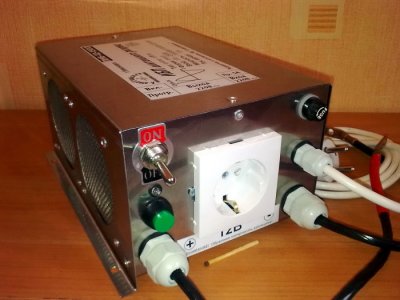
High-quality On-Line UPS It can also replace a stabilizer, since voltage equalization is its additional function.
But the UPS type «Line-Interactive» (including with a correct sine wave) in terms of the efficiency of stabilizing electric current is inferior to traditional stationary stabilizers.
Accordingly, experts recommend connecting gas boilers to provide emergency power as follows:
- On-Line UPS, from it - a cauldron.
- Stationary stabilizer, to it - a source of the type "Off-Line" or "Line-Interactive", and then the boiler.
What types of sources are there?
Conventionally uninterruptible power supplies can be divided into 3 categories:
- Off-Line, in which a small-capacity battery and a voltage converter are installed.
- Line-Interactive, which are technically similar to Off-Line, but also have an integrated simple voltage stabilizer.
- On-Line, which have a full-fledged dual converter with an output voltage stabilization system.
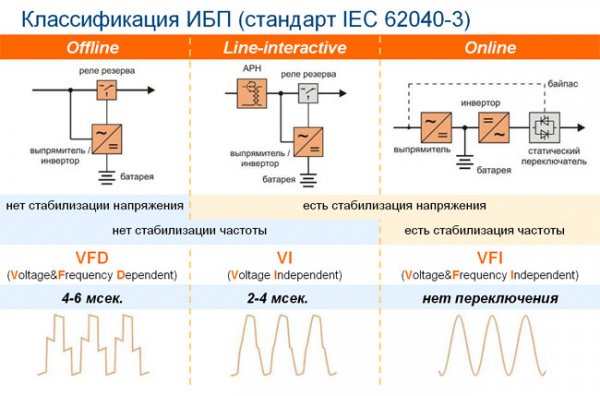
Photo 1. Comparison of three types of UPS: Offline (left), Line-interactive (center) and Online (right).
Off-Line type device turn on only if the input voltage drops below the mark 170-175 V or rises higher 240-250 V. In this situation, the device disconnects from the network and powers the connected boiler using an integrated battery. As a rule, such devices are now rare. Their main drawback is vulnerability to voltage surges.
The most common type of device is the "Line-Interactive". In addition to emergency power supply, they slightly stabilize the output voltage. This type of uninterruptible power supply is conditionally is divided into 2 subspecies:
- with an irregular (approximated) sinusoid;
- with a correct sine wave.
Second subspecies is preferable, since the device "produces" a more stable voltage. But, as a rule, it is produced for the use of an external battery pack. By the way, such devices are often also called "stabilizer with UPS function". In essence, it's one and the same.
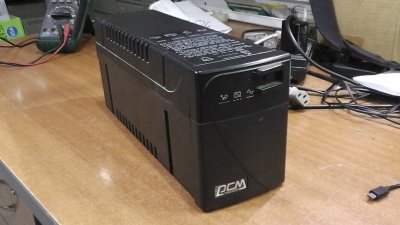
The most modern version of the uninterruptible power supply is "On-Line" type device.
It continuously accumulates charge in the installed battery and constantly powers the device from it, thereby providing a stable and consistent output voltage for the connected device.
The only significant drawback of such devices is use of expensive batteries (like AGM). In the same «Line-Interactive» The battery power is switched on only if the input voltage is either completely disconnected or becomes unstable (goes beyond the permissible input voltage).
Power and battery life
The UPS power rating indicates its possible peak load. Most gas boilers do not consume more than 300 W in peak mode (when the pump, ignition, and combustion chamber fan are all on), but this information should be checked in the technical data sheet. In standard operating mode, consumption, on average, is up to 150 W. Accordingly, the purchased UPS must have a power rating higher than the peak power of the boiler.
Reference. Some uninterruptible power supplies indicate power in VA (watt hours). Translate VA to W, you can use the formula: VA*0.6=W.
The battery life directly depends on the capacity of the batteries installed in the UPS, as well as on the level of electricity consumption by the boiler itself (this indicator is best calculated using wattmeters plugged into a socket).
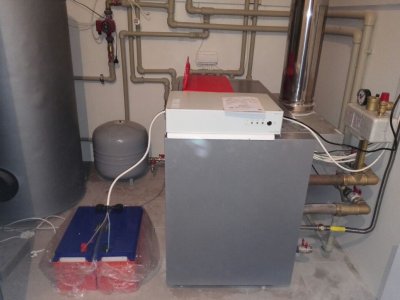
The simplest models use lead-acid batteries 7—12 Ah. In more expensive ones - up to 100 Ah.
Formula for calculating battery life: T=U*Ah*N*K/P, Where: T — battery life in hours. U — voltage of the installed battery (in most UPS — 12 volt batteries).
Ah — battery capacity. N — number of batteries. K — conversion factor (you can use the “universal” one — 0.75). P — average power consumption of the boiler in watts.
What kind of batteries are installed in UPS
The following types of batteries can be used in UPS today:
- lead acid;
- lithium-ion;
- nickel-cadmium.
The most common option (and the one that experts recommend giving preference to) is lead-acid. They are inexpensive, capacious, require minimal maintenance, are easy to connect, and charge quickly. They are conventionally divided into liquid and gel (depending on the physical state of the electrolyte used). The latter are more reliable and durable, but are more expensive.
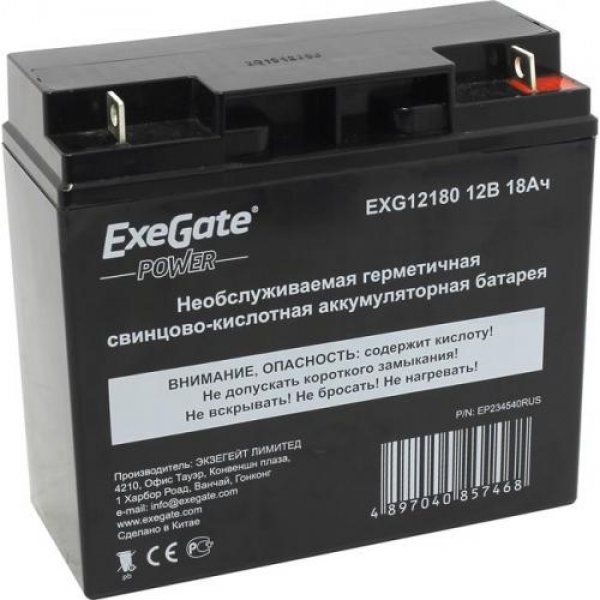
Photo 2. Lead-acid battery for uninterruptible power supply from the manufacturer ExeGate Power.
The only drawback of all lead-acid batteries is their rapid failure. with frequent use. They are designed to work infrequently and for short sessions. That is, they are suitable if the electricity at home is turned off rarely and for a short time.
Lithium-ion — are more durable than lead-acid batteries, but also more expensive. However, when idle, they begin to lose their capacity. Accordingly, they are not suitable if the need for emergency power is rare. But for regular use, when they have to be at least partially discharged 3-4 times a month, they are perfect.
Nickel-cadmium — although they are produced using old technology, they are durable and resistant to temperature changes. Disadvantages: batteries are not serviced, are highly toxic (it is better not to use them in residential premises), are expensive, and also have a “memory effect”.
Attention! Each UPS Compatible with only one type of battery. If a lead-acid battery was originally installed, then it will not be possible to install a lithium-ion or nickel-cadmium battery. Moreover, it is dangerous, since the charging algorithm of each of them is fundamentally different.
Size, weight and installation method
The size and weight of the UPS directly depend on the capacity of the installed batteries and the type of integrated voltage stabilizer.
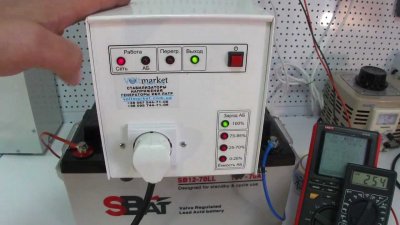
The uninterruptible power supply itself without batteries weighs, on average, from 2.5 to 10 kg. Battery at 7 Ah lead acid - about 1.5-2 kg.
Small devices usually have a built-in replaceable battery, while more expensive ones have an external one (which allows you to connect several batteries at once with a parallel connection).
Other characteristics to consider when choosing
And also when choosing a UPS, the following characteristics are taken into account:
- input voltage and frequency range (if the specified limits are exceeded, operation is switched to battery power only);
- output voltage waveform (better - with a correct sine wave).
As for the manufacturer, some of the best, according to consumers, in terms of price-quality, are UPS from the following companies:
- APC;
- LogicPower;
- Crown;
- PowerWalker;
- Mustek;
- Powercom;
- Stark.
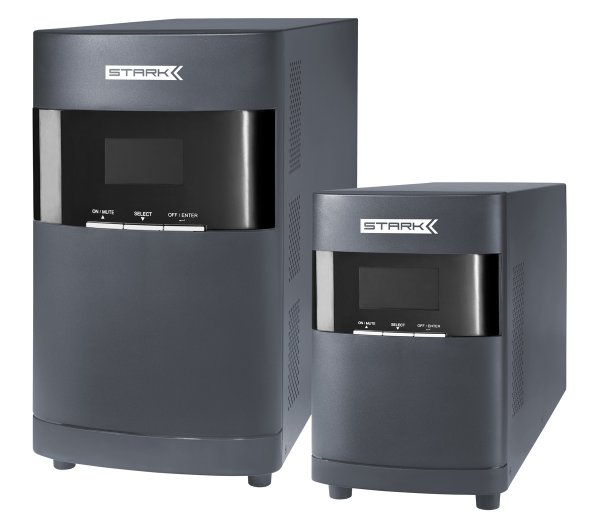
Photo 3. Two UPS of different sizes for gas boilers from the manufacturer Stark. The devices are equipped with an electronic display.
Useful video
Watch the video to learn how to choose a UPS for a gas heating boiler.
Which uninterruptible power supply to choose
The ideal option is something like "On-Line" with a true sine wave, working with external batteries. An alternative is a combination of a stationary voltage stabilizer with a true sine wave and a UPS of the type «Off-Line» (without voltage stabilization) or «Line-Interactive» (with a linear converter). It is recommended to calculate the capacity of the battery(ies) individually, based on how often the electricity is cut off at home and how quickly its supply is restored.





